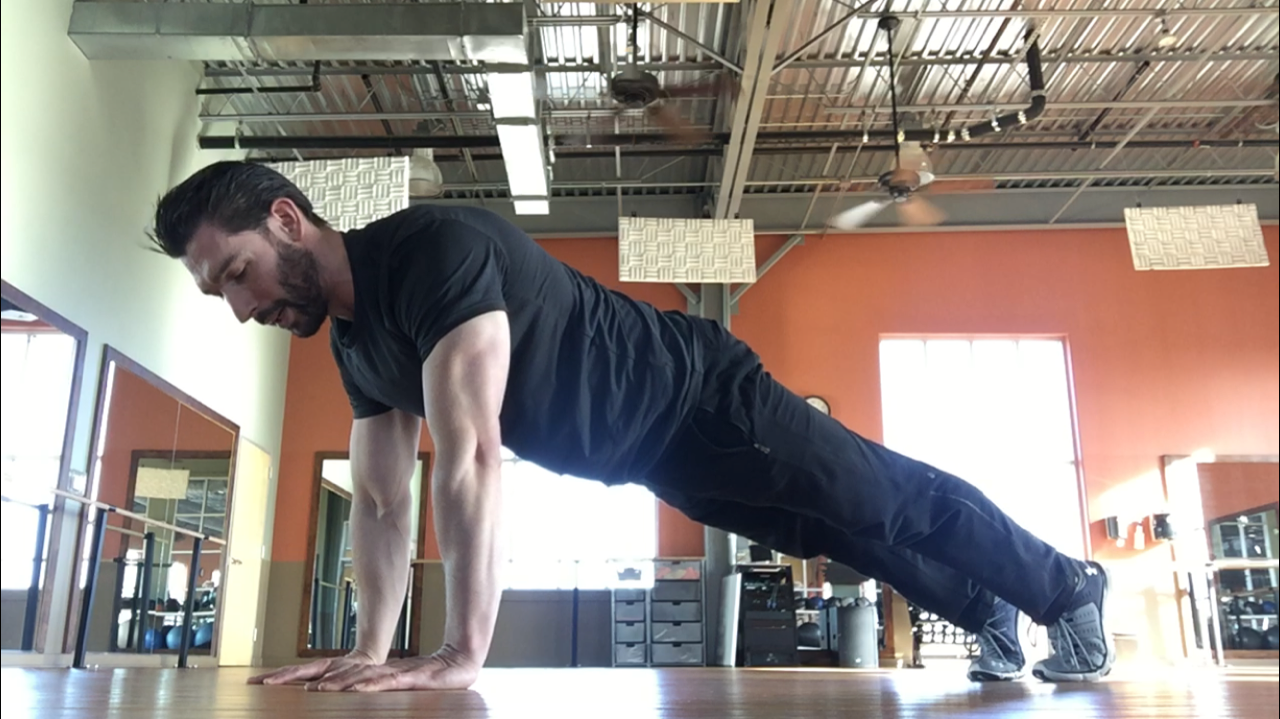Struggling with push-ups is a real thing, just ask my sister. She was recently asking me why they were so hard, and how you ever get better at them. But when she described what she was doing it was either struggling to do even just two or three regular plank position push-ups where her core would collapse and her elbows would flare out, or doing a ton from her knees that were super easy.
The answer, which is true for most exercises, is finding modifications.
It’s also important to understand the positions you’re attempting to achieve and finding ways to isolate them individually. The problem with attempting to “muscle through” standard push-ups when you don’t actually have the strength to do them is that your form is going to be awful. You’re just going to reinforce an improper movement pattern since you can’t achieve the correct one, or you’re going to hurt yourself, and maybe even both. So here are some ideas for how to progress your push-ups, as well as brush up on the movement itself.
Let’s quickly look at the Push-Up itself.
The start position for a standard push-up is a plank. Arms are straight, hands are under your shoulders, head is in neutral position, hips and core are engaged, and your body should be relatively straight from your shoulders to your heels. You don’t want your back arching so your stomach is falling to the floor, but you also don’t want your hips hiked up behind you, so your butt is sticking up in the air. A solid plank should be the first position you are able to get into. If you can’t get into this position then doing a push-up is a tomorrow problem.
Pretty much every exercise has a start position and a finish position. If you can get into both of those positions then the movement between the two should be relatively easy.
The focus then becomes on moving more weight, doing more reps, or increasing the tempo. The finish position for a push up is elbows bent and creating about a 45 degree angle between your body and elbows from your armpits, and your body braced a few inches above the floor. Hips and core are still fully engaged. If you could draw a straight line from one thumb to the other it should run across the middle of your sternum, or what some refer to as nipple line. A push-up is just alternating between these two positions in a controlled, stable manner. “Screwing” your hands into the floor (generating tension with the floor by applying clockwise pressure with the right hand and counterclockwise pressure with the left) will help stabilize your shoulder by engaging your lats and shoulder muscles as the head of the humerus bone rotates in the socket.
Now let’s get to the tips and modifications.
· Planks – If you struggle to do a plank then this is where you begin. You need to have the arm, shoulder, core, and chest strength to be able to maintain a plank if you want to be able to do a push-up.
· Incline Position Push-Ups – If you have access to a squat rack then you can set the bar to the height you need in order to be able to perform a push-up while practicing your form. With this method, “screwing” your hands in becomes “bend the bar. You can also try using a chair or the back of a couch, or anything that elevates your hands off the ground so you can work on building up your strength.
· Negative Position Push-ups – With this you will start in plank position and slowly lower yourself to the ground. From there, bend your knees and put them on the ground with your feet in the air and do a knee push up back to the top. Get back into plank position and slowly lower yourself down again. These will most likely be difficult but will help a lot in building strength.
· Finish Position Hold Push-ups – These start with you laying flat on the floor, hands just outside your chest, elbows 45 degrees off your body, and thumb line going across the center of your sternum. Push your self about 3 inches off the floor and try to hold the finish position of a push-up for 3 seconds, aiming for 10-12 reps. The time and reps should increase as you get stronger.
· Up Downs – This method is essentially alternating between a forearm plank and a straight arm plank. Start in a forearm plank and then alternate between the arm that helps push you up into a straight arm plank.
· Plank Walks – Any kind of movement in plank position will help strengthen your arms, shoulders, chest, and core. You can plank walk side to side, forward and backward, rotate in a circle, anything you want, get creative. As long as you’re in control of your movement and maintaining a stable plank position. I suggest doing this as a timed exercise for 30-60 seconds.
· Dumbbell Press and Tricep Extensions – A very straightforward way to build up the strength you need for a push-up is to work the muscles that are part of the movement. Doing flat bench or incline bench dumbbell presses will build up the push muscles in your chest, shoulders, and arms. And then you can specifically target your triceps by doing tricep extensions to both increase their strength, which will help with your push-up, but also tone your arms. Toning bonus FTW!
It’s likely that there are plenty more modifications out there besides these, and maybe there are even some that you come up with yourself. Be consistent, keep practicing, and make note of your progress so you know when to challenge yourself more. It may seem daunting at first, maybe even impossible, but you will definitely see progress and will end up fully capable of doing a push-up.



